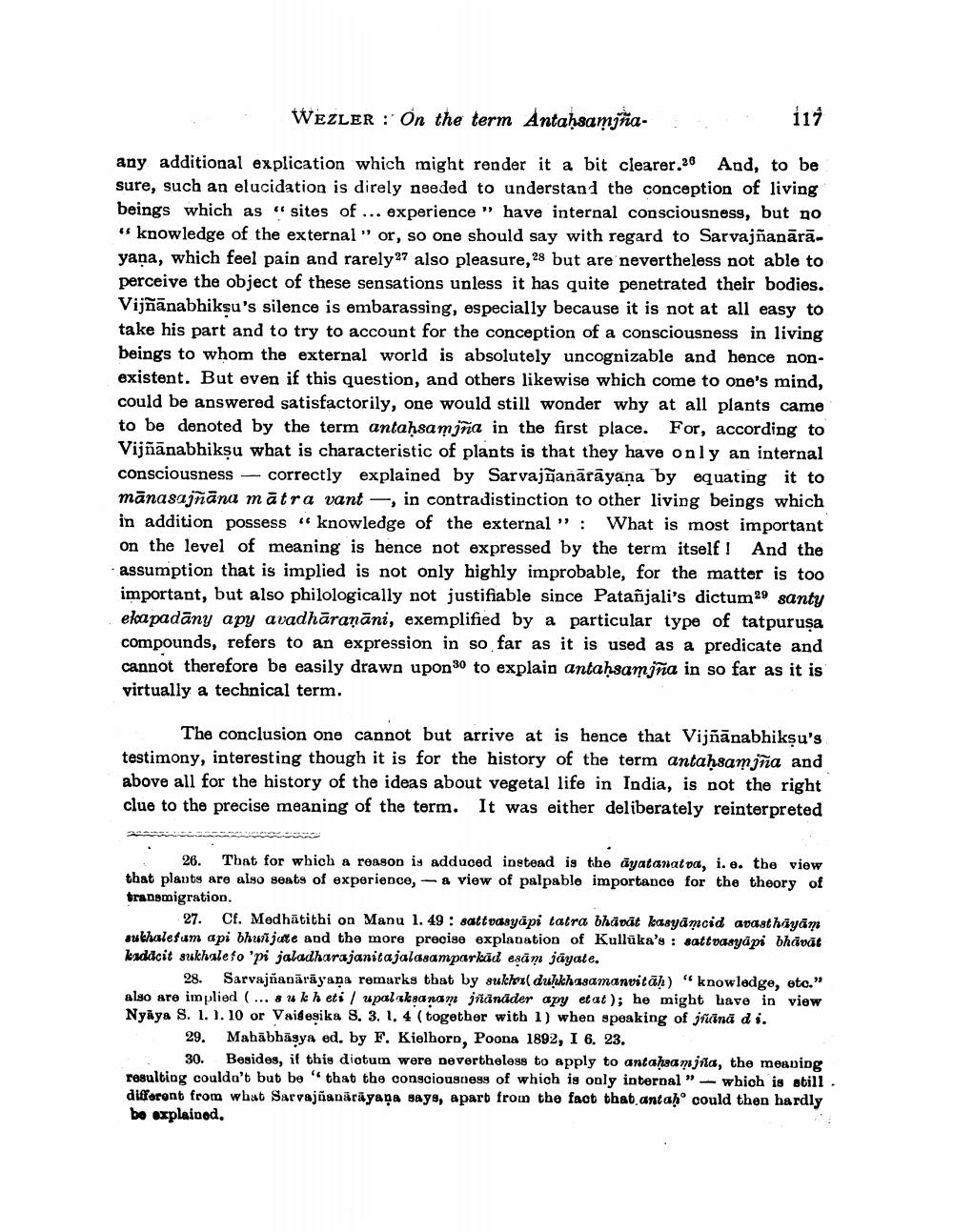Book Title: On Term Antahsamjna Author(s): A Wezler Publisher: A Wezler View full book textPage 7
________________ Wezler : On the term Antaḥsamjña- 119 any additional explication which might render it a bit clearer.26 And, to be sure, such an elucidation is direly needed to understand the conception of living beings which as "sites of ... experience” have internal consciousness, but no "knowledge of the external" or, so one should say with regard to Sarvajñanārāyaņa, which feel pain and rarely 27 also pleasure, 28 but are nevertheless not able to perceive the object of these sensations unless it has quite penetrated their bodies. Vijñānabhiksu's silence is embarassing, especially because it is not at all easy to take his part and to try to account for the conception of a consciousness in living beings to whom the external world is absolutely uncognizable and hence nonexistent. But even if this question, and others likewise which come to one's mind, could be answered satisfactorily, one would still wonder why at all plants came to be denoted by the term antaḥsamiña in the first place. For, according to Vijñānabhiksu what is characteristic of plants is that they have only an internal consciousness — correctly explained by Sarvajñanārāyana by equating it to mānasajñāna mātra vant , in contradistinction to other living beings which in addition possess knowledge of the external" : What is most important on the level of meaning is hence not expressed by the term itself ! And the assumption that is implied is not only highly improbable, for the matter is too important, but also philologically not justifiable since Patañjali's dictum 29 santy eka padāny apy avadhāraṇāni, exemplified by a particular type of tatpuruşa compounds, refers to an expression in so far as it is used as a predicate and cannot therefore be easily drawn upon 30 to explain antaḥsamjna in so far as it is virtually a technical term. The conclusion one cannot but arrive at is hence that Vijñānabhikṣu's testimony, interesting though it is for the history of the term antaḥsamina and above all for the history of the ideas about vegetal life in India, is not the right clue to the precise meaning of the term. It was either deliberately reinterpreted 26. That for which a reason is adduced instead is the āyatanat pa, i.e. the view that plants are also seats of experience, - & view of palpable importance for the theory of transmigration. 27. Cf. Medhätithi on Manu 1. 49: sattvasyäpi tatra bhävät kasyamcid avasthiyam suthalefum api bhur jate and the more precise explanation of Kullūka's : sattvasyāpi bhāvāt ksddcit sukhaleto 'pi jaladharajanitajalasamparkad esam jāyate. 28. Sarvajñanārāyana remarks that by suklo( dulkhasamanvitäh "knowledge, etc." also are implied (... 8 ukh eti / upalaksanam jñānāder apy etat); he might have in view Nyaya S. 1. 1. 10 or Vaidesika S. 3. 1. 4 (together with 1) when speaking of jrana di. 29. Mahabhigya ed. by F. Kielhorn, Poona 1892, I 6. 23. 30. Besides, if this dictum were nevertheless to apply to antahaa mjita, the meaning resulting couldn't but be " that the consciousness of which is only internal ” which is still different from what Sarvajñanārāyana says, apart from the fact that antaho could then hardly bo explained.Page Navigation
1 ... 5 6 7 8 9 10 11 12 13 14 15 16 17 18 19 20 21
